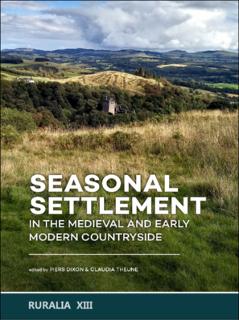| dc.contributor.author | Ødegaard, Marie | |
| dc.coverage.spatial | Norway | en_US |
| dc.date.accessioned | 2022-01-31T13:43:49Z | |
| dc.date.available | 2022-01-31T13:43:49Z | |
| dc.date.created | 2022-01-13T09:44:03Z | |
| dc.date.issued | 2021 | |
| dc.identifier.citation | Ødegaard, M. (2021) Markets and horse fighting sites in southern Norway – their socioeconomic significance, origin, and demise (AD 1300‑1800) In: P. Dixon, C. Theune (eds.) Ruralia XIII: Seasonal Settlement in the Medieval and Early Modern Countryside. Sidestone Press, Leiden, pp. 229-242. | en_US |
| dc.identifier.isbn | 9789464270105 | |
| dc.identifier.uri | https://hdl.handle.net/11250/2976050 | |
| dc.description.abstract | This study presents the first comprehensive mapping of a type of assembly site in South Norway for competitions, especially horse fights and races, called a skeid (ON skeið, English ‘race, run’). The number of place names indicates that these gatherings must have been of vital importance in prehistoric society. Skeids were in use in the Middle Ages and up to the 19th century in certain parts of the country. This study compares their locations to those of medieval markets, and it discusses their socioeconomic significance and differences in terms of the geological conditions for agriculture and animal husbandry between sites. Skeids and markets do not seem to be co-located, but evidence indicates that the sites were multifunctional, hosting competitions, trade, and barter as well as social activities, such as dancing. It is argued that the sale of horses from the fjord area and outfield resources, especially iron, from the Mountain Land was important for the long continuity of markets in the mountain area. The skeids were connected to different local communities’ organisation of common areas and to festivities connected with the end of the shieling season. The skeids and markets in the mountains escaped royal and ecclesiastical regulations and remained in use for a longer period of time than their counterparts in the rest of the country. In the coastal and fjord areas, the processes of urbanisation and industrialisation were more extensive, making shieling systems less attractive and important, which in the end contributed to the demise of the skeids. | en_US |
| dc.description.abstract | Diese Studie präsentiert die erste umfassende Kartierung bestimmter Versammlungsorte in Südnorwegen für Wettbewerbe, insbesondere für Pferdekämpfe und Pferderennen, die als Skeid (ON skeið) bezeichnet werden. Die Vielzahl der entsprechenden Ortsnamen weist darauf hin, dass diese Versammlungen in der historischen Gesellschaft von entscheidender Bedeutung gewesen sein müssen. Skeids waren im Mittelalter und bis zum 19. Jahrhundert in bestimmten Teilen des Landes vorhanden. Diese Studie vergleicht die Standorte mit denen mittelalterlicher Märkte und erörtert die sozioökonomische Bedeutung sowie die Unterschiede in Bezug auf geologische Bedingungen für Landwirtschaft und Tierhaltung. Skeids und Märkte scheinen nicht am selben Ort gewesen zu sein, aber es gibt Hinweise darauf, dass die Plätze multifunktional waren und Wettbewerbe, Handel und Tauschhandel sowie soziale Aktivitäten wie Tanzen veranstaltet wurden. Es wird argumentiert, dass der Verkauf von Pferden aus dem Fjordgebiet und von Ressourcen, insbesondere Eisen, aus dem Gebirgsland für die lange Kontinuität der Märkte in den Bergen wichtig war. Die Skeids waren mit der Organisation der öffentlichen Bereiche durch verschiedene lokale Gemeinschaften und mit Feierlichkeiten verbunden, die mit dem Ende der Shieling-Saison verbunden waren. Die Skeids und Märkte in den Bergen entgingen den königlichen und kirchlichen Vorschriften und blieben länger in Gebrauch als entsprechende Anlagen im übrigen Land. In den Küsten- und Fjordgebieten waren die Prozesse der Urbanisierung und Industrialisierung umfangreicher, was Shieling-Systeme weniger attraktiv und wichtig machte, was letztendlich zum Niedergang der Skeids beitrug. | en_US |
| dc.language.iso | eng | en_US |
| dc.publisher | Sidestone Press, Leiden | en_US |
| dc.relation.ispartof | Seasonal settlement in the medieval and early modern countryside | |
| dc.subject | middelalderhistorie | en_US |
| dc.subject | hestehandel | en_US |
| dc.subject | hestemarked | en_US |
| dc.subject | skeid | en_US |
| dc.title | Markets and horse fighting sites in southern Norway – their socioeconomic significance, origin, and demise (AD 1300‑1800) | en_US |
| dc.title.alternative | Märkte und Pferdekampfstätten in Südnorwegen – ihre sozioökonomische Bedeutung, Herkunft und Niedergang (AD 1300‑1800) | en_US |
| dc.type | Chapter | en_US |
| dc.description.version | publishedVersion | en_US |
| dc.rights.holder | © Marie Ødegaard | en_US |
| dc.subject.nsi | VDP::Humaniora: 000::Arkeologi: 090::Nordisk arkeologi: 091 | en_US |
| dc.subject.nsi | VDP::Humaniora: 000::Historie: 070::Middelalderhistorie: 081 | en_US |
| dc.source.pagenumber | 229-242 | en_US |
| dc.identifier.cristin | 1980129 | |
| cristin.ispublished | true | |
| cristin.fulltext | original | |
| cristin.qualitycode | 1 | |
